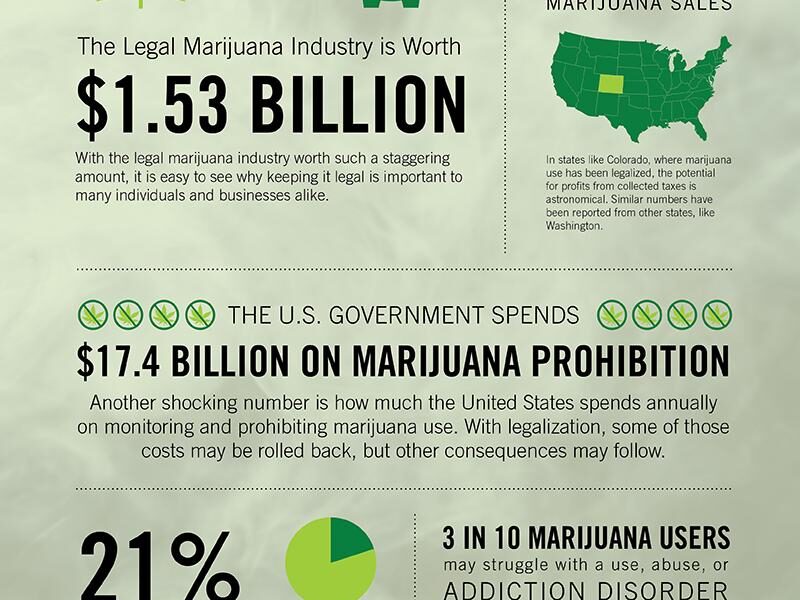Unlocking the Green Door: Fascinating Facts About Cannabis
As the world continues to evolve in its understanding of cannabis, this once-stigmatized plant is stepping into the light, revealing a treasure trove of intriguing facts that go beyond the smoke and mirrors. From its ancient medicinal uses to its burgeoning role in modern medicine and industry, cannabis is not just a source of debate; it is a complex organism with a rich history and promising future. In this article, we will explore the multifaceted world of cannabis, shedding light on its diverse strains, biochemistry, and cultural significance. Whether you are a curious newcomer or a seasoned enthusiast, prepare to embark on a journey that delves into the science, culture, and potential of one of nature’s most versatile plants. Join us as we navigate through the captivating facts about cannabis that might just change the way you think about this remarkable herb.
Table of Contents
- Exploring the Botanical Wonders of Cannabis
- Understanding the Science Behind Cannabinoids
- Navigating the Legal Landscape of Cannabis Use
- Practical Tips for Responsible Consumption and Safety
- Q&A
- Final Thoughts
Exploring the Botanical Wonders of Cannabis
Cannabis boasts an astonishing array of botanical characteristics that have captivated botanists and enthusiasts alike. This diverse plant falls under the Cannabaceae family, which not only includes marijuana but also the hemp plant, both featuring unique chemical compositions and uses. One of the most fascinating aspects of cannabis is its trichomes: tiny hair-like structures that produce valuable compounds known as cannabinoids and terpenes. These compounds contribute to the plant’s distinct aroma, flavor, and effects, making cannabis a true wonder of nature.
In addition to its intriguing chemistry, cannabis displays a remarkable versatility in its morphology. The plant can thrive in various environments, adapting its growth habits based on conditions. Here are some of the notable features:
- Leaf Shape Variability: Cannabis leaves can vary significantly in shape and size, with some strains exhibiting broad, finger-like leaflets while others are narrow and elongated.
- Height and Structure: Depending on cultivation techniques, cannabis can grow anywhere from less than a foot to over ten feet tall, leading to diverse garden aesthetics.
- Flowering Characteristics: Cannabis plants are dioecious; they can be male or female, with female plants producing the buds prized for consumption.
| Feature | Details |
|---|---|
| Growth Habits | Indica (short, bushy) vs. Sativa (tall, airy) |
| Life Cycle | Seedling, Vegetative, Flowering |
| Climate Adaptability | Tolerates tropical to temperate climates |
Understanding the Science Behind Cannabinoids
Cannabinoids are the chemical compounds found in the cannabis plant that interact with the body’s endocannabinoid system (ECS), a complex network of receptors, enzymes, and endocannabinoids. This unique system plays a crucial role in maintaining homeostasis, regulating various physiological processes including mood, appetite, pain sensation, and immune response. The two primary cannabinoids, tetrahydrocannabinol (THC) and cannabidiol (CBD), have distinct effects on the body, leading to a diverse array of therapeutic applications. While THC is primarily known for its psychoactive properties, CBD has gained recognition for its potential benefits without the High associated with THC.
Understanding how cannabinoids work involves delving into their interaction with the ECS. When cannabinoids bind to receptors in this system—mainly CB1 and CB2—they can either stimulate or inhibit signaling pathways, affecting everything from mental clarity to inflammation levels. Recent studies have uncovered a multitude of potential health benefits associated with cannabinoids, including but not limited to:
- Pain relief: Both THC and CBD have shown promise in alleviating chronic pain.
- Anxiety reduction: CBD has been studied for its anti-anxiety properties, making it a focal point for managing stress-related conditions.
- Anti-inflammatory effects: Many cannabinoids exhibit anti-inflammatory benefits, potentially easing symptoms of various diseases.
| Cannabinoid | Primary Effects | Applications |
|---|---|---|
| THC | Psychoactive, Appetite stimulant, Pain relief | Chronic pain management, Cancer treatment support |
| CBD | Anti-anxiety, Anti-inflammatory, Neuroprotective | Anxiety disorders, Epilepsy treatment, Skin conditions |
Navigating the Legal Landscape of Cannabis Use
Understanding the intricate and evolving regulations surrounding cannabis is essential for consumers and businesses alike. The legal landscape varies significantly from one region to another, influenced by local laws, public sentiments, and federal policies. Key factors affecting cannabis legality include:
- Type of Use: Medical vs. recreational use is often subject to different rules.
- Licensing Requirements: Businesses must navigate a complex system of permits and regulations.
- State vs. Federal Law: Some states have legalized cannabis, while it remains illegal federally, leading to potential conflicts.
To further dissect these complexities, it’s useful to look into how various jurisdictions approach taxation and regulation as well. For example, some areas impose heavy taxes on cannabis sales, while others maintain more lenient tax structures to encourage market growth. The following table summarizes a few states’ approaches:
| State | Legal Status | Tax Rate |
|---|---|---|
| California | Legal (Recreational & Medical) | 15% excise tax |
| Colorado | Legal (Recreational & Medical) | 15% excise tax |
| Texas | Limited (Medical Only) | N/A |
Navigating these regulations is crucial for anyone involved in the cannabis industry, whether for personal use or commercial endeavors. As legalization continues to expand, staying informed about changes in laws and policies can help avoid legal complications while also promoting responsible use.
Practical Tips for Responsible Consumption and Safety
Responsible consumption of cannabis is essential to ensure safety and to maximize the positive experience. Here are some practical tips to stay mindful while enjoying cannabis:
- Start Low, Go Slow: Begin with small doses, especially if you are a novice or trying a new strain.
- Know Your Source: Always purchase from licensed dispensaries to avoid contaminated or untested products.
- Understand the Product: Familiarize yourself with THC and CBD levels, as well as other cannabinoids and terpenes, to determine what effects you may experience.
- Stay Hydrated: Drinking water can mitigate dry mouth and help maintain comfort during your experience.
Incorporating safety measures is crucial to ensure that consumption is not only responsible but also enjoyable. Here is a quick overview of some key safety considerations:
| Consideration | Recommendation |
|---|---|
| Driving | Do not drive after consumption; wait until you are sober. |
| Public Space | Consume in designated areas only to respect community guidelines. |
| Mixing Substances | Avoid combining cannabis with alcohol or other substances to assess how you feel effectively. |
| Pre-existing Conditions | Consult with a healthcare professional if you have any health concerns or are on medications. |
Q&A
Q&A: Fascinating Facts About Cannabis
Q1: What is cannabis, and how long has it been used?
A1: Cannabis, commonly known as marijuana, is a plant that has been cultivated for thousands of years. Its use dates back to ancient civilizations in Asia and the Middle East, where it was valued for its medicinal, spiritual, and recreational properties. Archaeological evidence suggests that it may have been used as far back as 5000 BCE!
Q2: Is cannabis a drug, and how does it affect the body?
A2: Yes, cannabis is classified as a psychoactive drug primarily due to its active compounds, known as cannabinoids, with tetrahydrocannabinol (THC) being the most well-known. When consumed, THC binds to cannabinoid receptors in the brain, leading to various effects, such as altered sensory perception, mood changes, and, for some, a sense of euphoria.
Q3: What are the differences between THC and CBD?
A3: THC and CBD (cannabidiol) are the two most prominent cannabinoids found in cannabis. THC is responsible for the plant’s psychoactive effects—it’s what gets users “high.” In contrast, CBD does not produce a high and is often associated with potential therapeutic benefits, such as reducing anxiety and inflammation without the intoxication.
Q4: Can cannabis be harmful?
A4: Like many substances, cannabis can have adverse effects, especially when used irresponsibly. Potential risks include impaired cognitive function, dependency, and exacerbation of mental health issues in predisposed individuals. Moreover, smoking cannabis can have similar negative effects on lung health as tobacco.
Q5: What are some medicinal uses of cannabis?
A5: Cannabis has been recognized for its potential in treating a variety of health conditions. Patients have reported relief from chronic pain, nausea (especially from chemotherapy), and muscle spasms associated with multiple sclerosis. It’s also being researched for its potential to help with conditions like epilepsy, PTSD, and even some signs of neurodegenerative diseases.
Q6: How is cannabis consumed?
A6: There are many methods of consuming cannabis, including smoking, vaping, and edibles. Each method offers a different onset and duration of effects. For instance, smoking or vaping delivers a quicker high, while edibles take longer to digest but can result in a more intense and longer-lasting experience.
Q7: What is the legal status of cannabis around the world?
A7: The legal status of cannabis varies widely across the globe. In some countries, it is fully legalized for recreational and medicinal use, while others maintain strict prohibitions. Many regions are recognizing the potential benefits of cannabis and are moving toward legalization and regulation, but it remains a complex and evolving legal landscape.
Q8: Can cannabis be grown at home?
A8: Depending on local laws, home cultivation of cannabis can be permitted or restricted. Where it is legal, cultivating cannabis can be a rewarding hobby, offering users the opportunity to grow their own strains and experience the plant in its most natural form. However, it requires knowledge of growing conditions, nutrients, and care.
Q9: What should beginners know before trying cannabis?
A9: For those new to cannabis, it’s crucial to start slow and be mindful of the strain and dosage. Understanding how different strains affect individuals can guide a more pleasant experience. It’s also wise to be in a comfortable environment, especially when trying edibles, as their effects can be unpredictable!
Q10: What does the future hold for cannabis research and legislation?
A10: As research into cannabis continues to grow, we can expect a deeper understanding of its potential benefits and risks. The conversation around legalization is also gaining momentum, suggesting that more places may embrace regulated access to cannabis, aiming to promote safety, education, and responsible use.
—
This Q&A illuminates various aspects of cannabis, encouraging readers to engage with the topic thoughtfully while considering both its historical significance and contemporary complexities.
Final Thoughts
As we navigate the intricate tapestry of cannabis, it’s clear that this versatile plant carries with it a rich history, a compelling range of uses, and ongoing debates that challenge societal norms and personal perspectives. Whether viewed through the lens of medicine, recreation, or culture, the facts surrounding cannabis invite us to explore further. Understanding its complexities allows for informed discussions and decisions, bridging the gap between myth and reality. As research continues to unfold and attitudes evolve, staying educated about cannabis can empower individuals and communities alike. embracing knowledge is the first step toward a more nuanced conversation about this remarkable plant and its place in our world.


